Regular visits to dental practices are a certainty in the dental sector. But how can dentists entice customers to use their dental practice over others?
In a world where online presence reigns supreme, it’s imperative to distinguish your dental business apart from your competitors. An aesthetically pleasing website and a well-run company aren’t enough to attract new clients.
Dentists can utilise content marketing strategies successfully on their websites to grow their business and reach new potential customers.
When patients are looking for a dental service near them, they will turn to a search engine, like Google, for help.
But what is content marketing? How do you use digital marketing for dentists?
Whether you’re an experienced dentist with a well-established business or a fresh-faced professional eager to increase their customer base, content marketing offers unparalleled opportunities for experienced dentists with established businesses and newcomers eager to expand their customer base.
What is Content Marketing?
As a long-term strategy, content marketing focuses on delivering relevant, knowledgeable, high-quality content to sell your business.
Your content should exhibit so much value, that when a potential customer organically lands on your website, they make an enquiry or purchase.
Content marketing can help your target keywords to rank higher in search engine results pages, increasing online visibility.
The most common forms of content marketing are:
1. Blogs
Having a blog section on your website where you frequently publish new content can attract new customers.
When users land on blog posts, they will have typed a question into a search engine.
For example, users may search ‘How much do porcelain veneers cost in the UK’. You could include this as a section on a blog or even the H1 title of an article to appear in organic search results, leading the user to click on your website.
Blog posts improve SEO and are a cheaper way of boosting your organic traffic and client base.
2. Video
If you want to engage an audience quickly, videos can be a good option for you, although cost more money.
Video content can come in the form of:
– Webinars
– Courses
– Live videos
– Self-hosted Videos
– Informational Videos
– Product Reviews
A variety of content can be created with videos which engage your target audience.
Video content marketing helps raise your online profile, engage your audience and trigger emotions necessary for building a long-term relationship.
As dental practices are usually in a single location, you will be a relatively small business. Some ideas for small business videos are:
– Behind the scenes
– Showcasing your products
– Introduce yourself and your team
– Dental trends
3. Email
Are you interested in utilising your list of customer emails?
Email content marketing is a type of content marketing which dental practices can use to make customers aware of new lines of products, services or discounts.
It is a softer way of engaging your audience and can be personalised to include, for example, their first name.

The screenshot shows an example of email marketing a dentist uses. They utilised their customer’s email to send reminder emails of their appointments.
You can even use email automation services like MailChimp to help you compose an email marketing campaign.
Remember that conciseness is crucial for success in email marketing. So, before sending, find and remove unnecessary words from the composed email. For this, professionals usually prefer a summarising tool. Since it automatically condenses the given text by eliminating all the extra words.
In the dental sector, you can utilise email marketing by upselling your current client base to additional services and sending reminder emails. Create separate email lists for your clients depending on what services they are undergoing, and suggest further treatments.
4. Infographics
If you want to implement eye-catching content into your marketing strategy, infographics may be a perfect option.
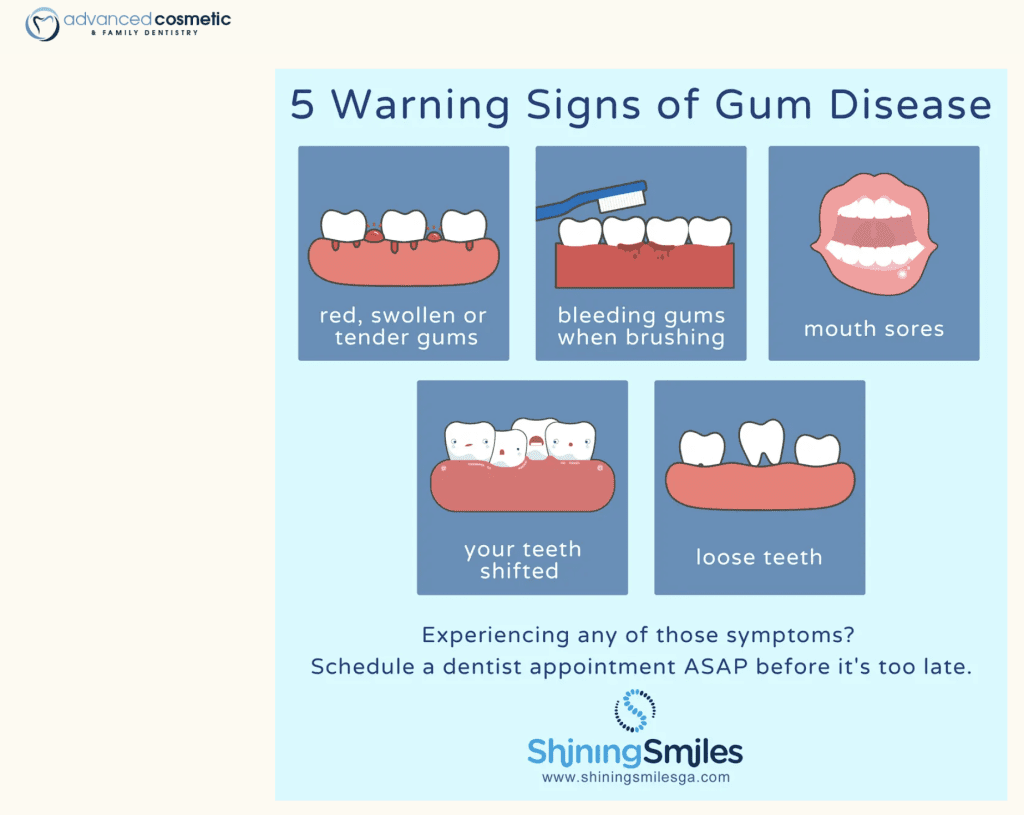
Above, you can see an example of an infographic that a dentist recently published. It highlights the important signs of gum disease that the reader will need to know about, but in a fun and interesting way. This is a good example as it also features a CTA of ‘Schedule a dentist appointment ASAP before it’s too late.’.
As a bright and vibrant option, they are captivating ways to display statistics, content or processes designed to engage your audience with your content. Users will be more drawn to exciting, colourful images rather than long pieces of dull text. Infographics are designed to engage the audience and provide detailed information, which can drive conversions.
5. FAQs
Having a list of FAQs on a website can help users find the answers to their questions.
For example, users might want to know what happens at a dental consultation or how long a new patient appointment takes. This information can be displayed in a quick fact sheet on your website.
FAQs are usually added to the bottom of blog posts, on social media reels/carousels or even a separate informational pages.
When you include FAQs on a page, you can implement ‘FAQ Schema’. This is a specialised content markup code you can add to a list of questions and answers.
Google then can read this markup and can generate rich snippets if your content is considered relevant.
You can use a schema generator to help you generate FAQ schema code, and add it to your website.
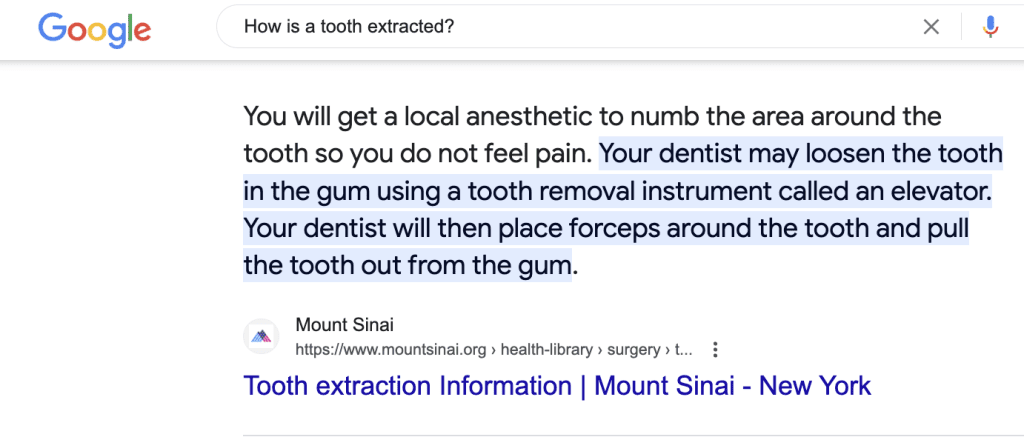
Above is a good example of FAQ schema. The question of ‘How is a tooth extracted’, which is widely searched by users, is ranking for a featured snippet. Featured snippets appear at the top of organic search and users are more likely to click on your website.
Content Marketing: 10 Tips for Dental Businesses
1. Include A Call To Action
As a way to push users to take action, a call-to-action can increase bookings, phone calls or other leads through your website.
Implementing a clear call-to-action in your content ensures your hard work isn’t wasted. Why write content without prompting your readers to get in touch with you?
Having a strong CTA in your content can eliminate decision fatigue that readers may be experiencing. CTAs with a sense of urgency can also boost your conversion rate.
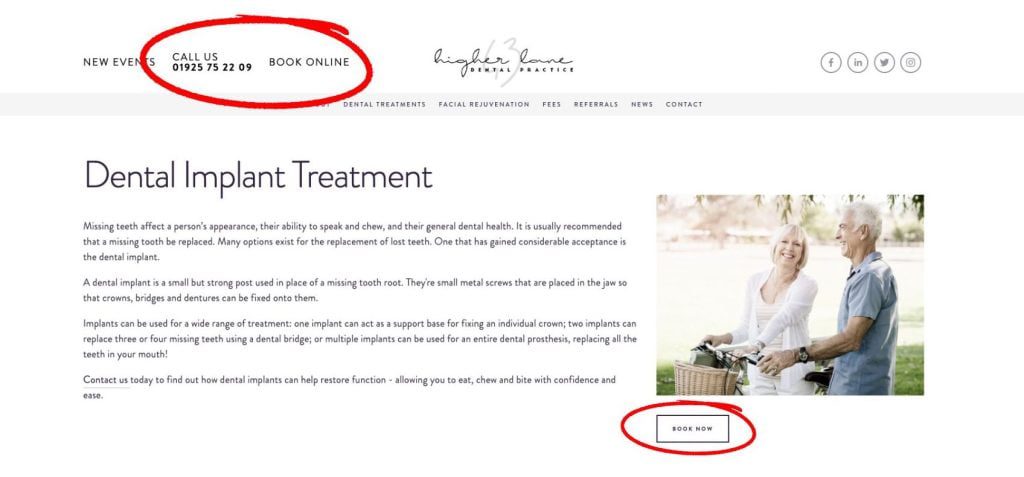
The example above shows two clear CTAs in the header, instructing the user to call them or to book an appointment online. These are sticky and are visible to the user at all times.
The second example is within content reading ‘Book Now’, instructing the user to book the ‘Dental Implant Treatment’ they have just read about.
Examples of calls-to-action in content can be:
– Enquiry Forms
– Buttons e.g. ‘Download Now’ or – ‘Purchase Today’.
– Normal text linking the user to another page
A CTA should be concise, making it more persuasive.
Try and start with a verb, instructing the reader to perform an action, then follow with an adverb. For example, ‘Buy Now!’.
Some calls-to-action for dental websites attracting new customers are:
– Contact Us
– Get Started
– Learn More
– See How…
– Start Your…
Every dental content page should have some form of CTA, especially if your prime goal is to attract more customers.
2. Define Your Audience
When writing content, you need to choose who you are aiming to reach, as you can’t begin writing until you know who your audience is.
Sit down with your dental team and discuss what your customers ask the most. Or even better, learn about your audience through enquiries or emails.
What are your current customers asking? Is this information on your website? If not, could it be added?
Create the ‘ideal customer’ persona. What would they want to know from your content?
Knowing your audience in depth will help you to attract the correct customers to your dental practice.
3. Write In-Depth Content
It is known that longer content can perform better in search engines.
So, why wouldn’t you dive in deep with a dental subject for users to explore?
You should include everything they need to know about the chosen topic so the user doesn’t need to seek additional information elsewhere.
You should refrain from writing content for the sake of it. Research what your customers want to know. Make it relevant to your audience.
Keep in mind that each article you create should only cover one topic in-depth, and target only 1-2 core keywords.
4. Understand Your Audience’s Thought Process
What is your typical customer’s thought process?
What do your customers need to know about your business or services to be able to book an appointment at your dental practice?
You must know the answers to these questions to create valuable content for your target audience.
You will be wasting your time generating content that your customers will not find useful.
Put yourself in your audience’s shoes. If you were searching for ‘alternatives to traditional braces’, what would you want to discover?
More than likely, you would want to know about the services a dental practice can offer a patient who isn’t looking for the traditional approach to braces. If you were to decide to write a blog post detailing the different types of braces available to patients, you would need to include the benefits, disadvantages, price points and relevant information regarding each type of brace.
CTAs need to be included as you now know!
5. Use A Pillar Content Cluster Model
If you want to create an enhanced reading experience for your users, you need to adopt a pillar content cluster model.
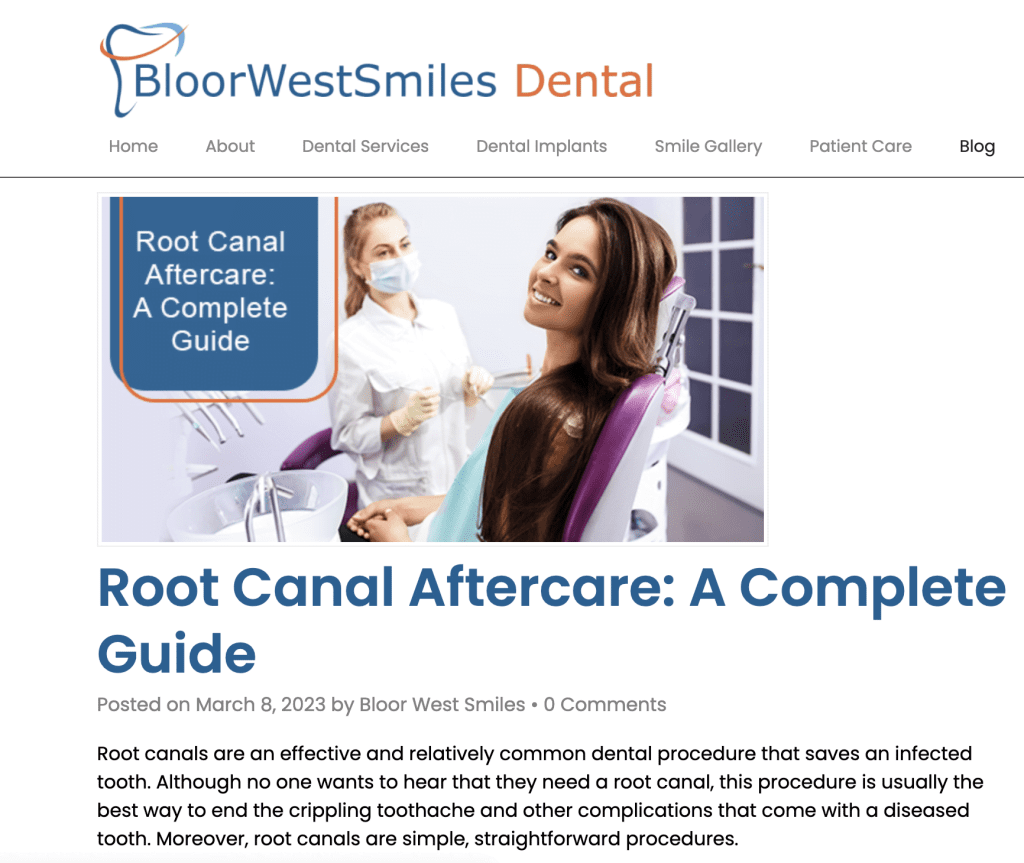
Above, a dentistry website called ‘Bloor West Smiles Dental’, produced an article titled ‘Root Canal Aftercare: A Complete Guide’. This is a great example of pillar content. Numerous smaller articles can be produced linking to this content. For example, ‘5 Signs You May Need A Root Canal’ could link to this pillar content, and vice versa.
In short, pillar content covers an umbrella topic. It will encompass a complete subject, giving a user everything they need to know about a topic. You then use smaller cluster articles to support the pillar piece.
Internal linking is used to connect pages, which tells search engines that the topics are related.
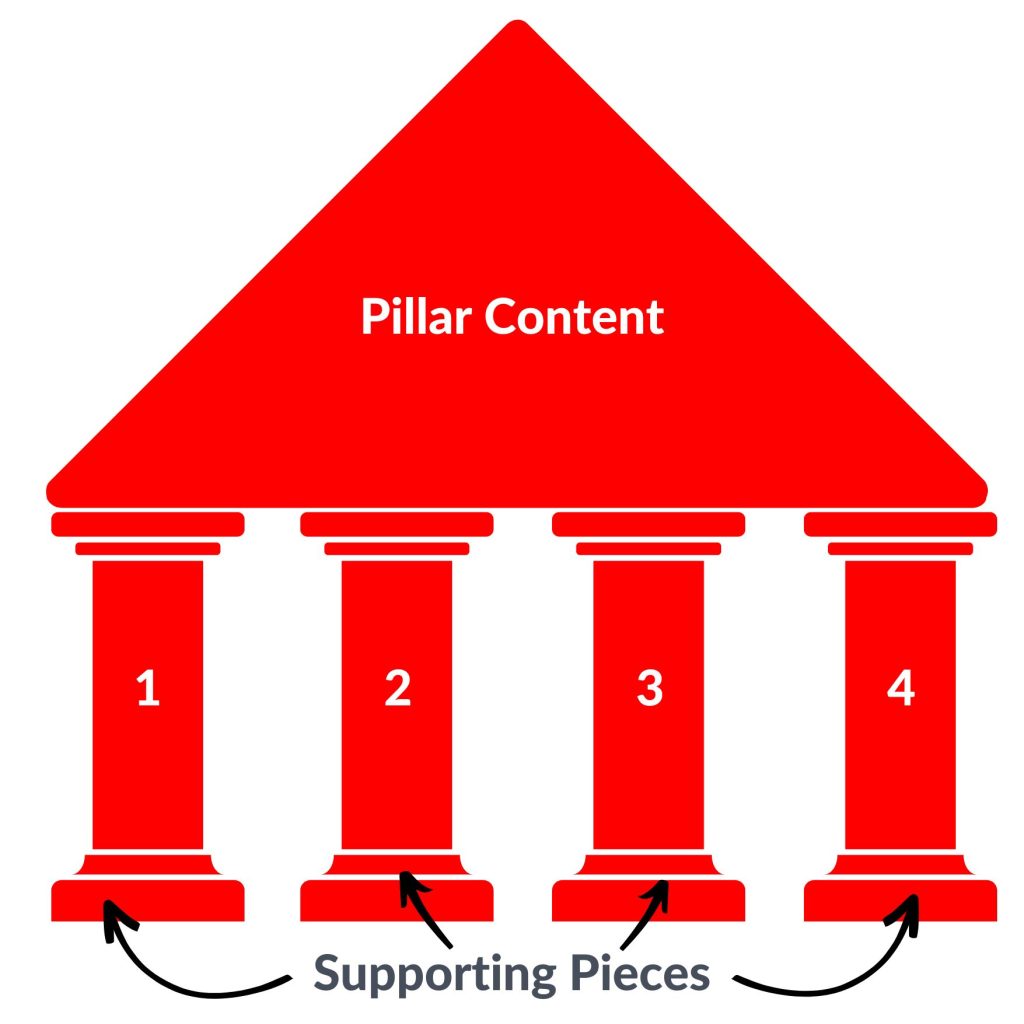
From the image above, you can see the way a pillar content model works. We’ve used a building as an example. The roof displays the pillar content, which is held up by the supporting articles, showing the more supportive articles you have, the stronger your pillar content will be.
6. Repurpose Existing Content
It takes time to write engaging and informative content.
However, repurposing content is an easy way of reaching wider audiences and growing your customer base.
As a dental practice, you might have already tried offline traditional marketing methods, like brochures or leaflets about your dental practice.
What if we said you could recycle and reuse the content on your brochures and leaflets?
For example, you’ve created a leaflet about Dental Implants listing the potential benefits your customer could experience.
This could be turned into a blog post titled ‘The 8 Benefits You WILL Experience From Having Dental Implants’.
Or, you have a blog post that performed incredibly well, created multiple leads and drove vast amounts of organic traffic to your website. This could be turned into a Youtube or TikTok video to reach a wider audience who use these platforms.
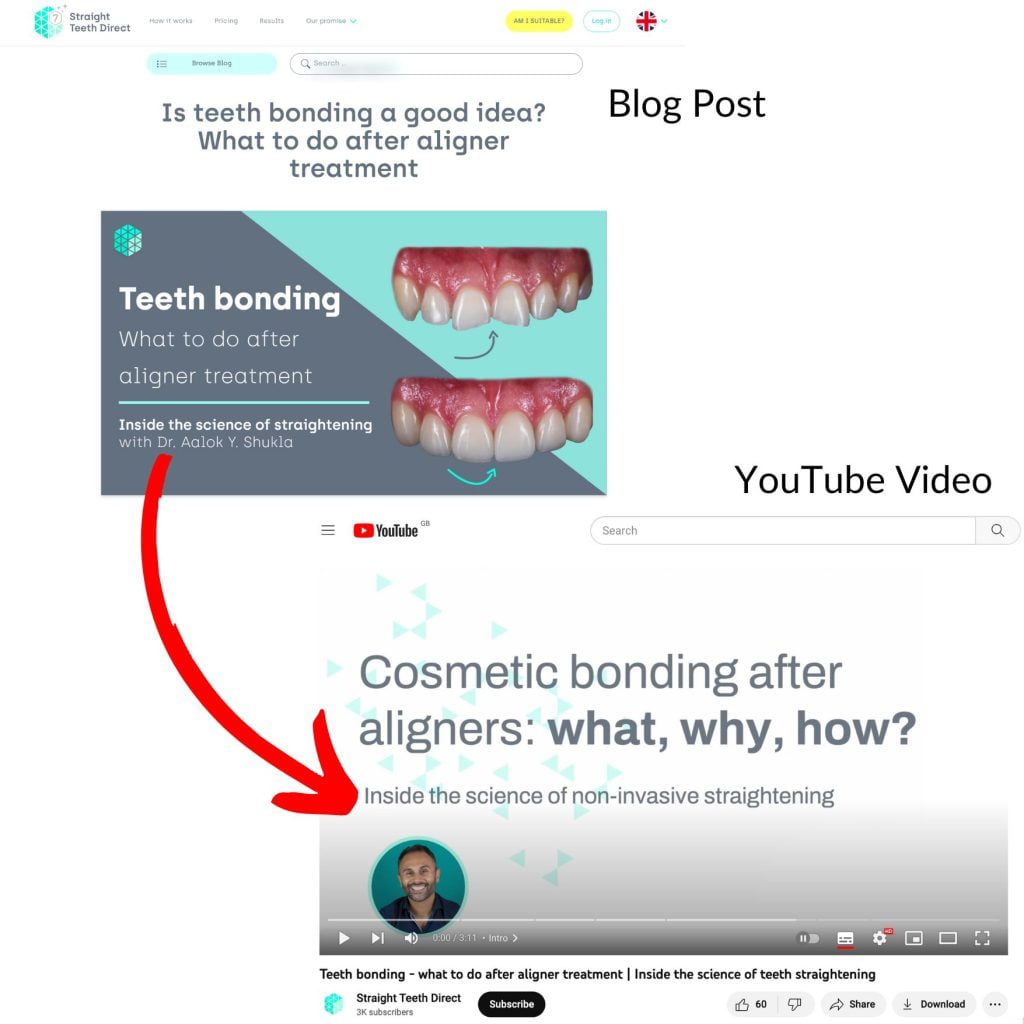
Above you can see a dental business called ‘Straight Teeth Direct’ took a blog post called ‘Is teeth bonding a good idea? What to do after aligner treatment’. They have repurposed this into a YouTube video to target a different audience.
7. Publish Your Original Research
With a bigger client base, you can gather original data.
Publishing original research can make your website look more authoritative in your field, creating linkable content that other businesses may find insightful by linking to your website.
You could create infographics with statistics to give your readers an insight into, for example, which treatments are most popular or how many clients suffer from a particular issue.
Or, a simple way to gather data, is to hand out a patient survey. Publishing the positive results once your survey is complete will help to attract new customers.
8. Implement SEO
If you’ve not heard of SEO before, it stands for Search Engine Optimisation. It is a crucial and long-term marketing method for websites to increase organic traffic through search engines, thus increasing leads and revenue.
SEO optimises content for search engines, like Google, so your website ranks high in search engine results pages for target keywords.
Developing SEO-friendly content should always be actioned with search engines in mind.
This used to mean stuffing your content with keywords, which is now a black-hat SEO technique and is frowned upon.
Instead, SEO is now a much wider field and there are many pieces of the puzzle you will need to build. You will need to perform extensive keyword research to discover what content you should produce.
If you want to look at keywords yourself, we like to use SEMRush and AlsoAsked for keywords and FAQ ideas.
Content and SEO work hand in hand. If you want your business to grow and excel, you need to do both.
9. Avoid Using Technical Dental Jargon
Think about your target audience. If you use words like ‘mesial, buccal, occlusal and incisal’, will they understand?
When businesses use incoherent technical jargon in their content, their intended audience becomes less trusting and less likely to stay on the website.
If you plan on discussing technical topics, you will want to simplify it. After all, your audience will not know much about the dental services you offer or the dental jargon you will use with staff on a daily basis.
However, this does depend on the audience. Some industries will engage with complex writing and topics.
Try and use layman’s terms or metaphors that the reader will understand and make the concepts you are discussing more accessible.
Additionally, if users aren’t using technical jargon in search terms, Google might not display your content to them. Using simple terms can expand your search traffic dramatically and creates content that targets your audience.
Bear in mind if you decide to use technical jargon, ensure you explain what it means.
10. Utilise Social Media Posts
Content marketing isn’t just about your dental practice’s website.
You can also write content for social media. This could be for LinkedIn, directing your attention to other dentists, or sharing your blog posts on social media.
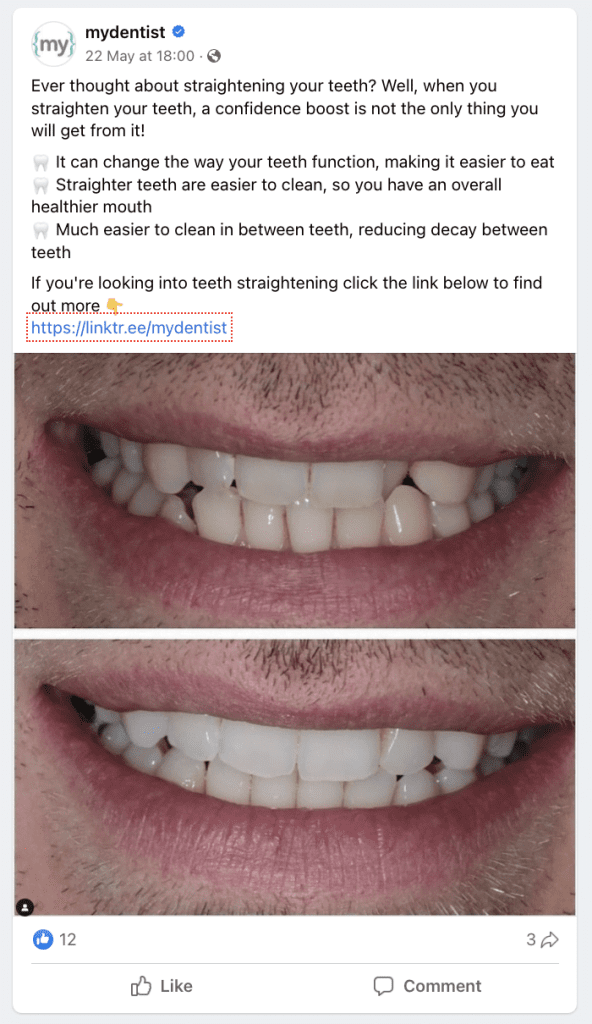
As you can see from the screenshot above, a nationwide dentist utilises social media by mainly posting patient results and in-house news. The example above showcases the great results from using a teeth-straightening process, including a small section of content enticing the user to contact the company.
Posting on platforms like Facebook and Twitter, allows you to reach a different audience to blogs on your website.
You could use infographics or links to your newly published blog posts, with a piece of content explaining what they are.
Using hashtags on social media in your content is also a great way to attract new customers.
There has been an increase recently in the number of users turning to social media to find local businesses or services, which is why utilising social media content is important.




